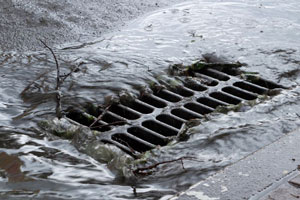
By Sarah Wilson, Healthy Planet Staff Writer
As storms get wetter and stronger, all of us with yards are on the frontlines of water management. If each of us managed our water a bit more effectively, we would help save people downstream heartache and our towns the expense of expanding stormwater management systems.
When we use stone to slow water down, we allow more of it to soak into the earth, replenishing groundwater, and watering our plants naturally—at no further effort or expense.
Here are three ways I use stone on our property to manage water.
Edging
Edging a bed with pavers or natural stone not only visually defines the bed, making it look instantly tidier, but it also slows runoff.
On our land, I also used a single line of pavers to prevent water from backing into the corner of the house. That corner of our basement used to get wet in heavy rains. Not anymore. For less than twenty bucks and about twenty minutes, it solved a problem that had frustrated the previous owners for years.
Plant Protection
Our ground is so hard that squirrels almost instantly dig up newly planted additions because, I think, the ground is softer there. So, when I plant, I ring the new plants with stones to keep the critters at bay. Works well for that but I’ve found it also keeps the water near the plant for longer.
Permeable Barriers
This is a fancy name for a line of stone across a slope. Such a line allows water to seep through it. A solid dam just forces the water elsewhere, which can create erosion problems.
On our property, I noticed an area collecting water after heavy rains, so I installed a line of pavers at the downhill edge of it. This makes a nice damp area for moisture-loving native plants. Such an area on my dry land adds to the biodiversity and will allow that water time to seep in, watering everything in the vicinity.
With climate change, all of us with yards are rainwater managers. Simple changes can give your plants more resources in the dry times and our stormwater systems less to deal with in the wet times. Both are worthy goals.


